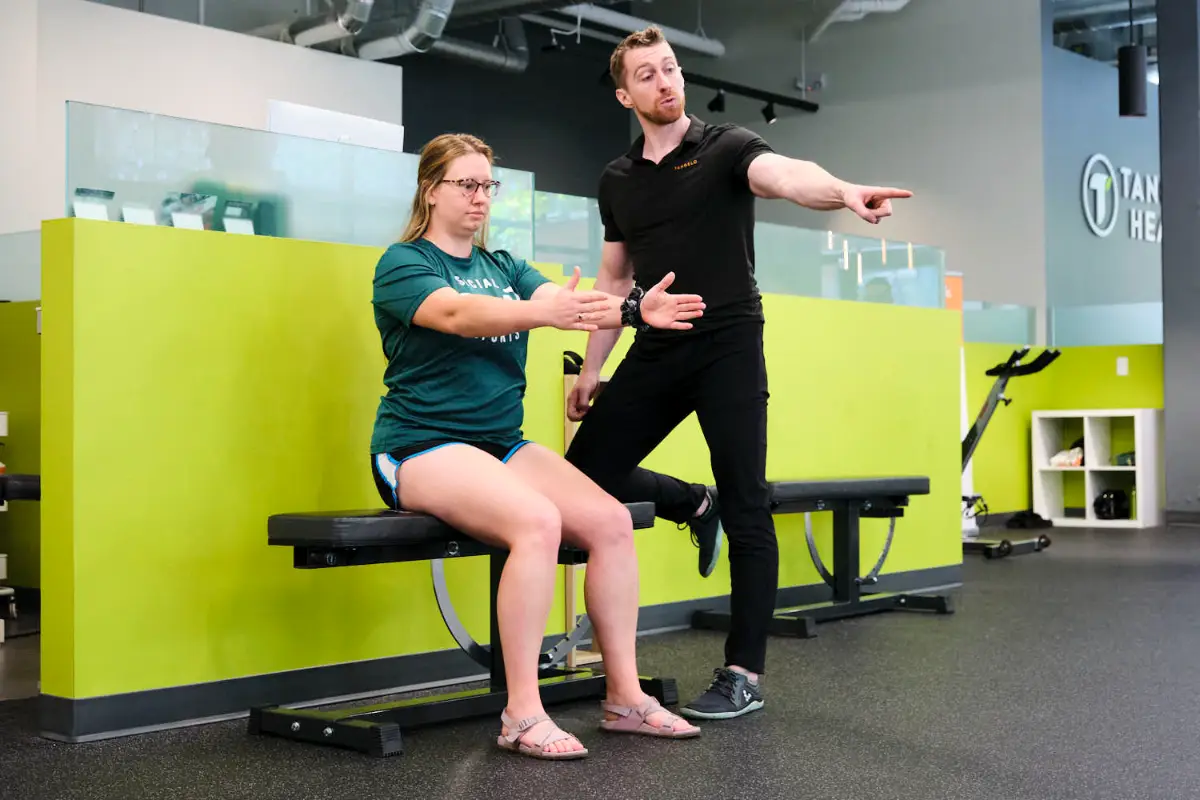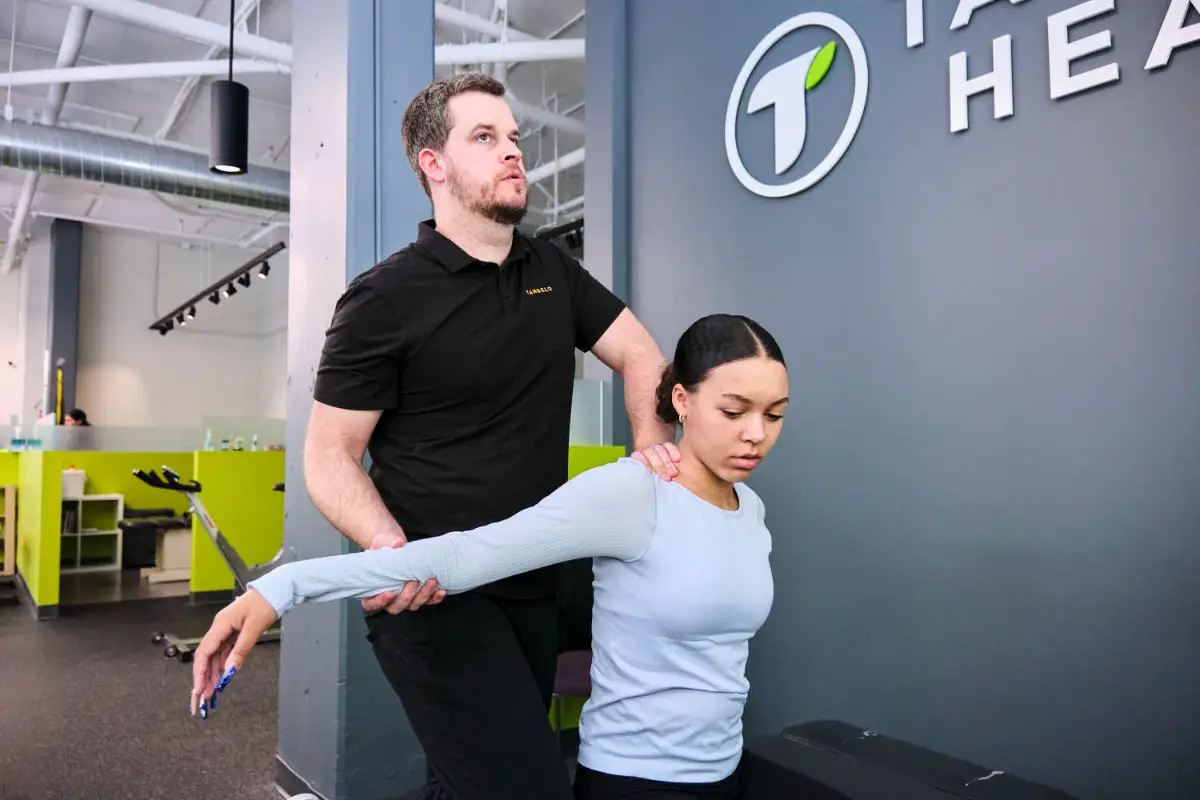
A pinched nerve can make everyday things hard. Maybe your neck aches after driving. Maybe there’s a zing down your arm when you turn your head. Or your lower back sends pain into your leg when you stand up. The good news is that most pinched nerves respond well to simple, conservative care. If you are looking for pinched nerve treatment in Seattle, Tangelo Health builds a plan around you. Our team blends movement-based chiropractic services, spinal decompression therapy, and easy-to-follow rehab so you can feel better and move with confidence. Many people improve with a combination of activity tweaks, stretching, and guided exercise, especially early on (Fisher, 2025).
What Is a Pinched Nerve?
A pinched nerve happens when nearby tissues press on a nerve and irritate it. That pressure can cause pain, tingling, numbness, or weakness. In the spine, this is often called radiculopathy. In the neck, it can travel into the shoulder, arm, or hand. In the lower back, it can follow the sciatic nerve into the leg. Pinched nerves can also happen outside the spine, like carpal tunnel at the wrist. If symptoms linger or limit your day, it is worth getting them checked (Fisher, 2025). Common causes include herniated or bulging discs, arthritis, spinal stenosis, posture overload, and repetitive strain. Sometimes a simple movement or long day at a desk sets things off.
How We Treat Pinched Nerves at Tangelo
Our goal is to reduce pressure on the nerve, calm irritation, and restore easy movement. Your plan may include the following:
Gentle Chiropractic Care
With precise adjustments, our chiropractic services help joints move the way they should. That can take pressure off sensitive nerves and reduce stiffness. Research suggests spinal manipulative therapy works as well as other recommended conservative options and is most helpful when combined with exercise and education (Gevers-Montoro et al., 2021).
Non-Surgical Spinal Decompression
Our spinal decompression therapy gently stretches the spine to create more space for irritated nerves. This can be useful for cervical and lumbar radiculopathy, especially when a herniated disc is part of the picture. Sessions are comfortable, and many people notice relief within a few visits.
Simple Rehab You Can Stick With
We will show you the right stretches and strength moves to support your neck or lower back without flaring symptoms. Think short routines that fit your day and build momentum. This conservative approach of activity changes, stretching, and strengthening is a standard first step for pinched nerves (Fisher, 2025).
Education That Prevents Flare-Ups
Small tweaks go a long way. We will coach you on desk setup, lifting habits, sleep positions, and daily posture so your progress lasts. If your symptoms match a specific pattern like leg pain from the lower back, explore sciatica. If your pain starts in the neck and travels into the arm, see our neck pain page.

What To Expect During Pinched Nerve Treatment in Seattle
Most people start to feel improvement within a few weeks. Consistency matters. We will adjust your plan based on how your body responds so you keep moving forward. Clinical guidance supports using manual therapy with exercise for neck and back pain, and building care around your goals and daily routine (Gevers-Montoro et al., 2021).
When To Seek Pinched Nerve Help
Reach out if you notice any of the following:
- Pain that shoots into an arm or leg
- Ongoing numbness, tingling, or weakness
- Symptoms that do not improve after a couple of weeks
- Trouble doing normal daily tasks
Early support helps calm irritation and prevents a small issue from becoming a long-term one (Fisher, 2025).

FAQs about Pinched Nerve Treatment in Seattle
How long does a pinched nerve take to heal?
Mild cases may settle in one to two weeks with activity changes and the right exercises. Moderate cases often need a few weeks to a few months. A consistent plan that blends chiropractic, decompression, and simple home rehab tends to speed recovery (Fisher, 2025).
Can a pinched nerve affect your whole body?
It can send symptoms into connected areas. For example, irritation in the cervical spine can cause pain or tingling into the arm or hand. Irritation in the lumbar spine can follow the sciatic nerve into the leg.
What causes a pinched nerve?
Common causes include a herniated disc, arthritis, spinal stenosis, posture and repetitive strain, or a sudden overload. Learn more on our neck pain and sciatica pages.
Is it better to rest or move with a pinched nerve?
Short-term rest can help calm a flare. After that, gentle movement and guided exercise are important for lasting relief. We will tailor activity to your symptoms so you make steady progress without setbacks (Fisher, 2025).
Start Pinched Nerve Treatment in Seattle
You do not have to live with daily zings, numbness, or stiffness. Get a plan that fits your life and targets the real cause. Schedule your visit and start moving comfortably again with chiropractic services, spinal decompression therapy, and step-by-step rehab. If you don’t want to live another moment in discomfort, contact our Seattle chiropractic clinic in Green Lake or West Seattle.
References
- Fisher, J. (2025, January 2). Got a pinched nerve? Strategies and treatments for pain relief. Harvard Health Publishing. https://www.health.harvard.edu/diseases-and-conditions/got-a-pinched-nerve-strategies-and-treatments-for-pain-relief
- Gevers-Montoro, C., Provencher, B., Descarreaux, M., Ortega de Mues, A., & Piché, M. (2021). Clinical effectiveness and efficacy of chiropractic spinal manipulation for spine pain. Frontiers in Pain Research, 2, 765921. https://doi.org/10.3389/fpain.2021.765921


